You've probably been using Cursor for months. It made you way faster at coding, and you've been telling everyone about it. Then Anthropic dropped Claude Code, and suddenly your developer friends are abandoning their IDEs for... a terminal?
The FOMO is real. But you're also skeptical. How could a CLI tool be better than an IDE?
In this guide, I'll break down everything you need to know: how much they actually cost (including the hidden stuff), which features are legit, and most importantly, when to use each tool.
Here’s what you need to know if you’re in a hurry:
Quick comparison
| Feature | Cursor | Claude Code |
|---|---|---|
Interface | VS Code-based GUI | Terminal/CLI |
Starting price | Free (limited), $20/mo (Pro) | $20/mo (with Claude Pro) |
Token context | 200k-1M (Max mode) | 200K-1M (Sonnet in Max plan) |
Multi-model | Yes (GPT, Claude, Gemini) | No (Anthropic only) |
Learning curve | Low (if you know VS Code) | Medium (terminal comfort needed) |
Core philosophy differences
- Cursor: AI-enhanced IDE. You drive, AI assists
- Claude Code: AI agent in your terminal. AI drives, you supervise
Pricing at a glance
- Cursor: Free → $20 Pro → $200 Ultra
- Claude Code: Included with Claude Pro ($20) or Max ($100-200)
- Cursor counts requests, Claude Code counts tokens
Decision framework preview
- Pick Cursor if you want a familiar environment with AI assistance
- Pick Claude Code if you want an AI that takes the wheel
- Use both if you can afford it (they’re genuinely complementary)
Cursor is VS Code rebuilt with AI as part of the editor's DNA. It looks and feels exactly like VS Code (because it's forked from it), but the AI sees what you see, knows what you know, and most importantly, can actually make the changes instead of just suggesting them.
You keep your extensions, your keybindings, your themes. Everything works like before, just… smarter.
Claude Code is a terminal-first, agentic programming tool powered by Claude models. There's no GUI and no buttons. Just you, a terminal, and an AI that can see your entire codebase and execute commands directly.
The radical difference is that you don't tell it what changes to make (though you can). Instead, you tell it what to accomplish. It plans multi-step tasks, executes them, checks results, and fixes problems autonomously.
The interface shapes how you think, how you work, and how fast you move. Let's see how different these approaches really are.
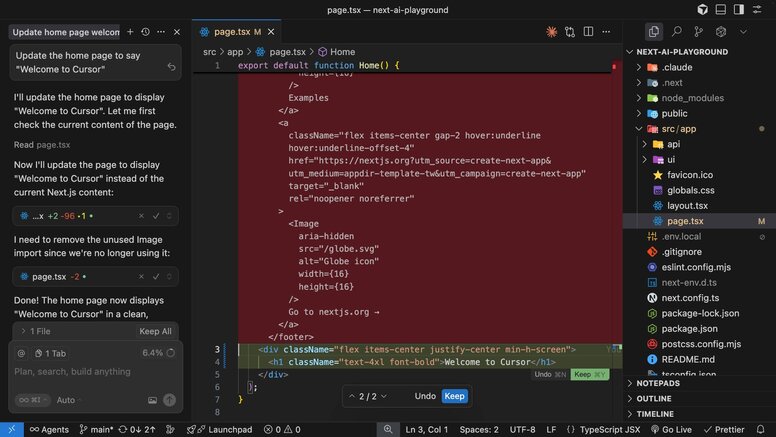
Cursor feels like home if you're coming from VS Code. Your file explorer sits on the side, tabs line the top, and terminals anchor the bottom. The AI features blend seamlessly into this familiar layout. When you invoke the AI, changes appear in your editor in real-time. You review them, tweak if needed, and ship. It's smooth, it's visual, and it never breaks your flow.
Cursor also has a web interface at cursor.com/agents for launching Background Agents remotely. Perfect for starting a build while commuting.
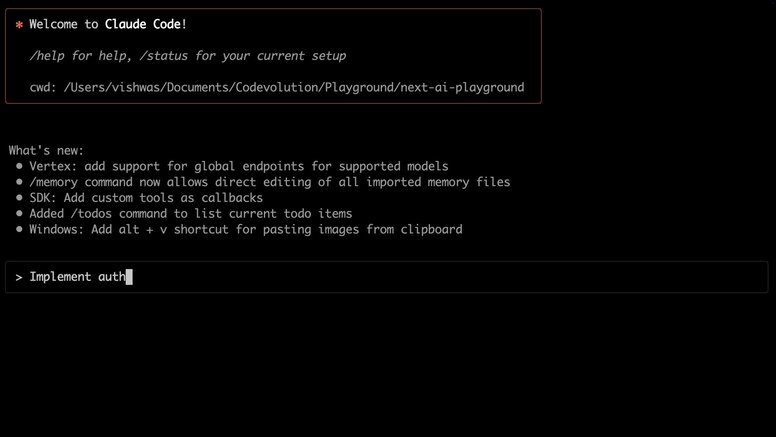
Claude Code is pure terminal. No GUI, no file tree, no buttons. Just a command prompt and an AI that can see your entire project. You tell it what needs to happen. Claude reads your codebase, shows you its plan, and executes. You watch it work through files, write code, run tests, and fix what breaks. It's autonomous but checks in at critical points.
The new native installer (currently in beta) means you don't even need Node.js anymore. Plus, you can hit Cmd+Esc from VS Code or JetBrains to launch it instantly. Claude automatically pulls in diagnostic errors from your IDE, so it knows exactly what's broken before it even starts.
Cursor integrates into your IDE workflow. Claude Code replaces it temporarily while it works.
Both tools generate code, but they approach it differently. The question is: how much control do you want?
Cursor gives you multiple entry points, each optimized for different scenarios:
- Tab completion: Predicts entire blocks with surprising accuracy. It even jumps across files to add imports or update related code. You start typing, it finishes your thought.
- Cmd+K: Highlight code and describe the changes you want. Perfect for surgical changes. Type "Add retry logic with exponential backoff," and watch the update happen in place.
- Agent mode: The workhorse for bigger tasks. Generates entire features across files while showing you exactly what it's planning.
Claude Code takes a more holistic approach:
- One command, complete implementation: Tell it "Add user auth with email verification..." and it generates routes, middleware, migrations and tests. The whole shebang.
- Reads first, writes second: It analyzes your entire codebase before generating anything.
- Tests as it builds: Writes code, runs tests, fixes what breaks, continues.
Cursor gives you exactly what you asked for. Claude Code gives you what you asked for plus everything it thinks you'll need. Sometimes that's overkill. Most of the time, it's exactly right.
Editing is where the gap widens.
Cursor keeps editing natural. You can still tweak a CSS color, rename a variable, or fix a typo by hand, just as you would in VS Code. AI assists when you want it, disappears when you don't. It's augmentation, not replacement.
The diff review is particularly smooth. When Agent suggests changes, you see them in familiar red/green diff format. Accept all, reject all, or cherry-pick individual lines. There's even a floating review bar for file-by-file decisions.
Cursor's checkpoints are your safety net. Every Agent change creates an automatic snapshot. Mess something up? Click "Restore Checkpoint" on any previous message, and you're back to that exact state. No more "git reset --hard" prayers.
Claude Code takes a different approach. You don't edit inline. If you spot a small mistake or want to tweak output, you prompt again and let Claude regenerate, or switch back to your traditional editor. For micro-edits, this feels clunky.
Cursor sees AI as an enhancement to manual coding. Claude Code sees manual coding as a fallback when AI isn't enough.
Different models excel at different tasks, and your choice affects both quality and cost.
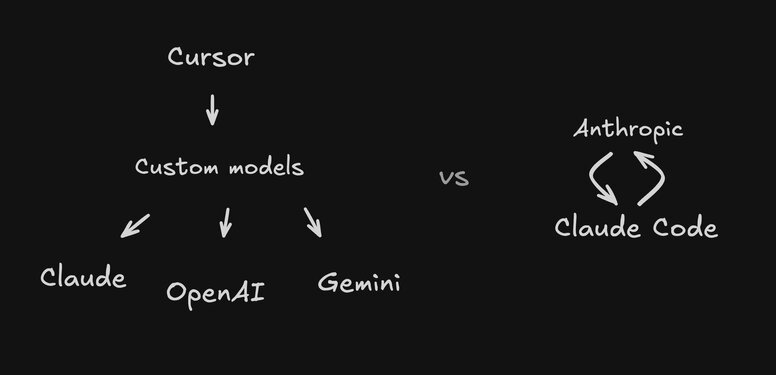
Cursor gives you the entire model buffet. OpenAI's GPT-5, Anthropic's Claude Opus 4.1 and Claude Sonnet 4, Google's Gemini 2.5 Pro and more. Switch mid-conversation if one model isn't delivering. The flexibility is real. Use Claude Opus 4.1 for refactoring, GPT-5 for architecture discussions and Gemini 2.5 Flash for quick iterations.
They've also added an "Auto" mode that picks the best model for each task. It even detects when a model is having issues and switches automatically. Convenient, but you lose some control.
Claude Code is Anthropic only. You get Claude Opus 4.1, Claude Sonnet 4 and a few older models. Switch between them with /model, but that's it. No GPT, no Gemini. The upside is less decision fatigue and more consistent outputs. Anthropic's models are consistently good at coding, so you rarely wish for alternatives.
Both support third-party providers (AWS Bedrock, Google Vertex etc.) for enterprise deployments.
Cursor offers variety and flexibility. Claude Code offers consistency and simplicity. Your choice depends on whether you want options or opinions.
This is where both tools show their true colors. How they handle context determines what they can accomplish, and this is where things get interesting.
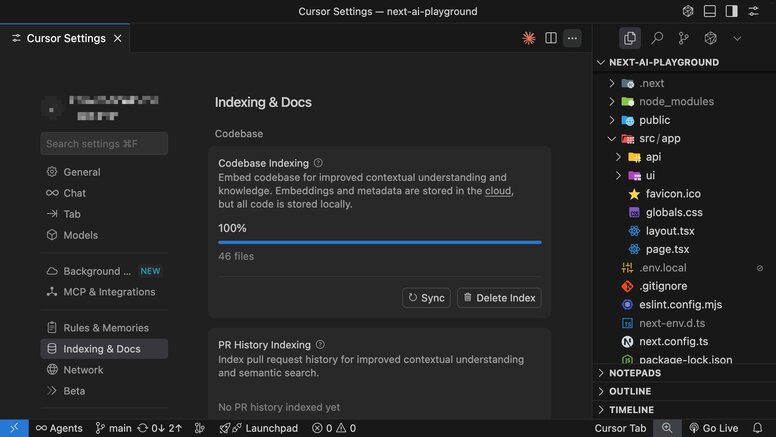
Cursor does something clever when you open a project: it indexes everything. Every file gets turned into embeddings, creating a semantic map of your codebase. Ask "where do we handle payment failures?" and it finds the relevant code even if those exact words never appear in your files.
The PR search feature is underrated. Cursor indexes all merged PRs from your repo history. When you ask "how have we implemented services before?", it pulls in historical changes with full context. GitHub comments and even Bugbot reviews get included if you've connected them.
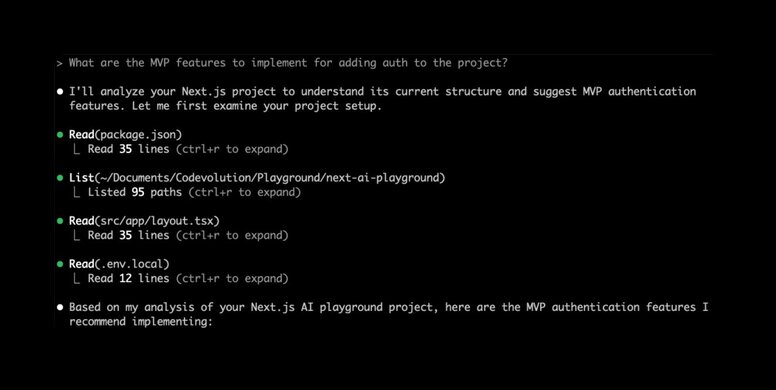
Claude Code takes a more exploratory approach. It reads files on demand, following imports and dependencies like a detective following clues. Surprisingly, it's very good at finding relevant files, but you burn tokens every time.
Both tools wrestle with the same beast: LLM context windows.
Cursor uses sophisticated condensation. Large files get compressed to show structure (functions, classes) rather than full content. When you include a massive folder, it creates an outline view with a tooltip showing exactly how many files made it in. The model can request to expand specific sections if needed.
You'll also notice automatic summarization for long conversations. Older messages get compressed to make room for new ones. You'll see "Summarized Messages" appear in the chat - the full context is gone, but key points remain.
Claude Code has seen major advances in context capacity. Claude Sonnet 4 now supports up to 1 million tokens of context on the Anthropic API. A 5x increase that lets you process entire codebases with over 75,000 lines of code or dozens of research papers in a single request. Claude Sonnet 4 now supports 1M tokens of context \ Anthropic This is currently in public beta and available through the Anthropic API and Amazon Bedrock, with Google Vertex AI support coming soon.
For Claude Code users specifically, the 1M context window is starting to roll out to Max plan subscribers (20x usage tier). If you have access, you can activate it with /model sonnet[1m]. However, the standard Claude Code experience still maintains a 200K token window for Claude Opus models. When you hit limits, it uses "compact mode" (trigger manually with /compact or let it happen automatically). Unlike Cursor's gradual summarization, Claude Code's compaction is more aggressive but somehow maintains better coherence for complex tasks.
The extended thinking mode in Claude Code is clever. By having Claude "think" before responding, it can work through complex problems without cluttering the conversation.
How do these tools remember your preferences and patterns across sessions?
Cursor uses a dual approach: Memories (AI-extracted patterns from your conversations) and Rules (explicit instructions you write). These can be project-specific or user-global, giving you fine control over what the AI knows about your preferences.
Claude Code uses the CLAUDE.md system - a hierarchical memory structure that cascades from enterprise to project to local levels. It's simpler conceptually but surprisingly powerful with its import system and directory inheritance.
Cursor handles continuity through chat tabs and history. Press Cmd+T for a new tab, each with its own context. Your chat history is stored locally in SQLite, searchable with Alt+Cmd+'. Use @Past Chats to reference previous conversations in your current session.
The "Duplicate Chat" feature is great for exploring alternatives. Click the three dots on any message, duplicate from that point, and explore a different approach without losing your original conversation.
Claude Code uses command-line flags for continuity:
-continue: Automatically resumes your most recent conversation-resume: Shows a conversation picker with details about each session- Session IDs for programmatic resumption
- You can use the Claude Code extension to spin up multiple instances in your editor
The experience is more deliberate. You explicitly choose to continue previous work rather than having multiple tabs open. Better for focused work, worse for exploration.
Background Agents are autonomous agents that run in isolated VMs in Cursor's cloud. Give them a task, they clone your repo, create a branch, make changes, run tests, and create PRs. All while you sleep (or pretend to work in meetings).
Setup requires .cursor/environment.json with install commands and startup scripts. You can even use a Dockerfile for complex environments. The agents have internet access, can install packages, and run indefinitely.
Auto-run removes the permission prompts. Set up your allow/deny lists carefully (allow test commands, block database modifications), and Cursor writes code, runs tests, sees failures, and fixes them without interrupting you. Combined with Agent Mode, it's eerily autonomous.
Planning with to-dos breaks complex tasks into trackable chunks. Agent creates structured lists that update in real-time as it works. If you've connected Slack, to-dos appear there too. Your PM will love watching features build themselves.
Privacy Mode for proprietary code:
- No code stored on servers
- Ephemeral processing
- No training on your code
- Full audit logs for compliance
Plan Mode (hit shift+tab twice) makes Claude think before acting. It creates structured plans with implementation details, potential issues, and decision points. You can modify the plan before execution. It automatically triggers for complex requests, or force it with "let's plan how to..."
Extended Thinking goes deeper. Use "think" for basic reasoning, "think hard" for complex problems, "ultrathink" for maximum depth. You actually watch it work through approaches, consider tradeoffs, and sometimes completely backtrack when it finds better solutions.
Subagents are specialized AI assistants for specific tasks. Create a "test-runner" subagent that proactively runs tests after every change. Build a "security-reviewer" that checks for vulnerabilities. Each has its own context window and tool permissions. Store them in .claude/agents/ for project-specific agents or ~/.claude/agents/ for personal ones.
GitHub Actions integration turns Claude Code into a CI/CD powerhouse. Mention @claude in any PR or issue, and Claude analyzes the code, implements fixes, and creates PRs. The /install-github-app command sets this up in minutes. Your team might not even realize the bug fixes are coming from an AI.
Claude Code SDK lets you embed Claude Code in your own applications. Available in TypeScript and Python, it provides programmatic access to all features. Build SRE bots that fix production issues, security scanners that patch vulnerabilities, or custom development tools for your team.
Autonomous workflows shine here:
- PR creation: Tell it "Implement rate limiting from issue #47 and create a PR." It reads the issue, implements, tests, and opens a PR with proper description.
- Test generation: Writes tests, runs them, identifies edge cases from failures, iterates until coverage is solid.
- CI/CD fixes: Reads failure logs, identifies problems, pushes fixes. Your broken builds fix themselves.
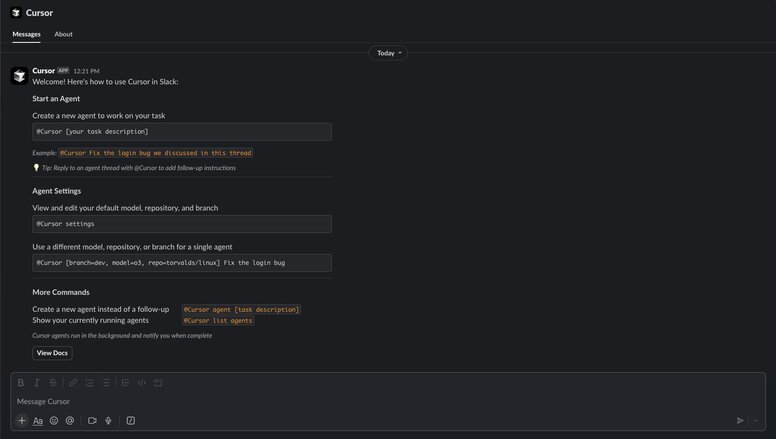
Cursor's dev team collaboration center around Background Agents and integrations. The Slack integration is particularly slick. You can mention @Cursor with a task, and it spins up a Background Agent. Your team sees progress updates in real-time, can add follow-up instructions mid-task, and gets notified when PRs are ready.
Bugbot reviews every PR automatically, catching issues before human review. It reads your .cursor/BUGBOT.md files for project-specific rules. Comments appear directly in GitHub with "Fix in Cursor" links that open issues in your local IDE.
The web interface at cursor.com/agents means anyone can kick off agents from their phone. Non-technical stakeholders can request features without touching code.
Claude Code's collaboration happens through GitHub Actions and shared configuration. Team members commit CLAUDE.md files and .claude/agents/ to the repo. Everyone gets the same context and specialized agents.
The GitHub Actions workflow is powerful but different. Instead of Background Agents, you get Claude running in GitHub's infrastructure. More integrated with CI/CD, less flexible for exploratory work.
Cursor and Claude Code are incredible for developers, but they keep the actual coding locked in terminals and IDEs. Your designer is still pinging you about button padding, your PM can't prototype without booking your time, and marketing is still waiting three sprints for their landing page.
At Builder.io, we built Fusion to give you the best of both worlds: all the AI coding power in a visual canvas your entire team can use.
Connect your GitHub repo, and suddenly everyone can ship real code through a visual interface. Designers drop in Figma frames and Fusion turns them into complete interactive components. PMs can test ideas without writing tickets. Marketing can actually ship that landing page themselves.
The AI understands your existing components and design system, so everything fits your codebase perfectly. Every change happens on git branches with automatic preview URLs, and the AI even responds to PR comments to fix build issues.
Your team gets autonomy, you get your time back, and everyone ships faster. You can try Fusion for free to see how it fits your workflow.
Alright, back to regular scheduled programming.
Cursor embraces parallel work:
- Chat tabs:
Cmd+Topens new tabs. Each maintains separate context. Run a refactor in one tab while debugging in another. - Background Agents: Launch multiple agents for different features. They work independently in separate VMs.
- Git worktrees: Not a Cursor feature per se, but they recommend using git worktrees with multiple Cursor instances for true parallelism.
Claude Code is more sequential:
- Single session focus: One conversation at a time in the terminal.
- Queued messages: Use Ctrl+Enter to queue follow-ups while Claude works.
- Subagents: Delegate specific tasks to specialized agents, but they run sequentially.
- Multiple terminals: Run separate Claude Code instances in different terminals (or the Claude Code extension) for parallel work.
Cursor's rules system has evolved into something comprehensive (maybe too comprehensive?):
You've got three types of rules to juggle:
- Project rules (
.cursor/rules): MDX format with metadata headers, auto-attachment by glob patterns, manual invocation with@rules - User rules: Global preferences in settings, plain text, always applied
- Agent instructions:
AGENTS.mdplain markdown file
Rules can reference files with @include, use nested directories, and support complex scoping. The UI shows all active rules with their status and source. It's powerful but can feel like configuring Webpack – endless possibilities, occasional confusion.
Memory system works alongside rules:
- Auto-generated from conversations by a sidecar model
- Requires approval before saving (privacy-first approach)
- Stored separately from rules but applied similarly
- Can be edited/deleted through the UI
Claude Code embraces simplicity with its CLAUDE.md hierarchy:
CLAUDE.md hierarchy (loaded in order):
- Enterprise:
/etc/claude-code/CLAUDE.md(IT-managed) - User:
~/.claude/CLAUDE.md(your defaults) - Project:
./CLAUDE.md(team standards) - Local:
./CLAUDE.local.md(personal overrides, gitignored)
Powerful features:
- Import system:
@path/to/filesyntax for modular configuration - Directory inheritance: CLAUDE.md files cascade down directory trees
- Session memories:
#prefix for temporary instructions (e.g.,# always use tabs) - Slash commands: Create reusable commands as markdown files in
.claude/commands/
Cursor uses commands (still in beta) for automation. Create .cursor/commands/ with markdown files defining reusable workflows. It's basically templated prompts – simple but limited.
Claude Code's hooks system is incredibly powerful:
- PreToolUse: Run before any tool execution (can block)
- PostToolUse: Run after tools complete
- UserPromptSubmit: Process prompts before Claude sees them
- Notification: Custom notification handling
- Stop/SubagentStop: Cleanup or continuation logic
Hooks can modify inputs, block operations, or trigger side effects. Write them in any language. The security implications are serious - these run automatically with your credentials.
Here's a practical example that auto-formats everything:
{
"hooks": {
"PostToolUse": [{
"matcher": "Edit|Write",
"hooks": [{
"type": "command",
"command": "prettier --write ${file}"
}]
}]
}
}The ecosystem around your coding tool determines what's possible. Let's see how connected these tools really are.
The ecosystem around your coding tool determines what's possible.
Cursor inherits VS Code's entire extension marketplace. Everything works. Your themes, GitLens, language servers, debuggers, terminal customizations, database explorers, REST clients. If it works in VS Code, it works in Cursor. That's thousands of extensions without any compatibility issues.
Plus native integrations that make it special:
- GitHub app for Background Agents
- Bugbot for automated reviews
- Slack for team coordination
Claude Code works with anything that has a CLI. GitHub CLI for PRs, Git for version control, your existing aws, kubectl, npm toolchain. It manages containers, runs deployments, and executes any command-line operation. Whatever you'd do in a terminal, Claude Code can do – usually better and definitely faster.
The new IDE integrations bridge the gap:
- VS Code extension (works with Cursor, Windsurf, VSCodium)
- JetBrains plugin (IntelliJ, PyCharm, WebStorm, etc.)
- Quick launch with Cmd+Esc
- Automatic diagnostic sharing so Claude knows what's broken
MCP connects AI tools to external services. Both Cursor and Claude Code support it.
Cursor makes MCP point-and-click easy. Add MCP servers in settings, pick from a curated list, authenticate, done. Popular integrations include Firecrawl for web scraping, Linear for projects, Google Drive for docs, Slack for team comms. Visual interface shows what's connected with easy on/off toggles.
Claude Code offers two configuration methods:
- CLI: Run
claude mcp add <server-name>and follow prompts - Direct config: Edit JSON for complex setups
More flexible but requires more setup. Servers can be scoped to project, user, or local level. The --scope flag controls where configurations live.
Both support the same MCP servers, but Cursor is easier for quick setup.
Both tools start at $20/month, but that's like saying both a Honda and a Tesla have four wheels. The details matter.
Cursor uses an API agent usage system. You pay for a tier, get a bucket of included usage, and different AI models burn through it at different rates.
The pricing tiers:
| Plan | Monthly Cost | What You Actually Get |
|---|---|---|
Free | $0 | 2-week Pro trial, then limited Agent requests and Tab completions |
Pro | $20 | $20 of API agent usage + bonus usage, unlimited Tab completions |
Pro Plus | $70 | $70 of API agent usage + bonus usage, unlimited Tab completions |
Ultra | $200 | $400 of API agent usage + bonus usage, unlimited Tab completions, 20x usage on all models |
The tricky part is that each model has different costs. Your $20 of API agent usage in Pro gets you roughly:
- 225 Claude Sonnet 4 requests
- 550 Gemini requests
- 500 GPT-5 requests
So if you prefer Claude (which many do for coding), you're getting half the requests compared to Gemini. Pro Plus and Ultra scale similarly:
- Pro Plus: 675 Sonnet 4 / 1,650 Gemini / 1,500 GPT-5 requests
- Ultra: 4,500 Sonnet 4 / 11,000 Gemini / 10,000 GPT-5 requests
Cursor adds bonus usage on top of these guaranteed amounts, but it varies based on their capacity.
The expensive gotchas:
Max Mode gives you those juicy 1M token context windows but consumes way more usage per request.
Looking at actual usage patterns:
- Just using Tab completion? $20 Pro is plenty
- Using Agent occasionally? $20 Pro usually works
- Using Agent daily? You'll need $60-100/month total (Pro Plus territory)
- Running multiple agents and automation? Welcome to $200+ Ultra land
Additional costs to watch for:
- Background Agents bill separately at API rates
- Bugbot is a separate $40/month subscription
- Sonnet with thinking mode costs double per request
Teams pricing is simpler at $40/user/month. Everyone gets 500 included agent requests per month. Most models cost 1 request, Claude Sonnet with thinking costs 2 requests, and MAX Mode pricing is calculated based on tokens at the model provider's API price.
Claude Code comes bundled with Claude Pro or Max. No separate subscription, but you share usage limits with the main Claude chat interface.
What each tier actually gives you:
| Plan | Monthly Cost | Message Allowance* | Context Window |
|---|---|---|---|
Claude Pro | $20 | ~45 messages every 5 hours | 200K tokens |
Max (5x) | $100 | 225+ messages every 5 hours | 200K tokens |
Max (20x) | $200 | 900+ messages every 5 hours | 200K tokens |
*Assuming short conversations with less compute-intensive models
The key thing to understand: is that every Claude Code command and every Claude.ai chat comes from the same pool. If you spend the morning chatting with Claude about a design doc, you have fewer messages for coding in the afternoon.
The 5-hour rolling window is both clever and constraining. You can burst when needed, but you can't bank messages for a weekend coding marathon.
Key limitation: All plans keep the same 200K context window. Max plans let you send more messages, but individual conversations have the same length limits as cheaper tiers.
Let's see what you actually get at different price points:
At $20/month:
- Cursor Pro: $20 of API agent usage + bonus, unlimited tab completions, Background Agents, Bugbot
- Claude Pro + Code: 5x free tier usage, about 45 messages per 5 hours
Around $70/month:
- Cursor Pro Plus: $70 of API agent usage + bonus, all Pro features
- Claude: Nothing at this price point
At $100/month:
- Cursor: Nothing at this price point
- Claude Max 5x: 5x more usage than Pro, 225+ messages per 5 hours
At $200/month:
- Cursor Ultra: $400 of API agent usage + bonus, 20x usage on all major models
- Claude Max 20x: 20x more usage than Pro, 900+ messages per 5 hours
On Cursor:
- Choosing expensive models (Claude Opus 4.1 costs way more than Gemini)
- Auto mode pricing: $1.25 per 1M tokens input, $6.00 per 1M tokens output
- Background Agents running overnight on large repos
- When you exceed your included monthly usage, you can purchase additional usage at cost or upgrade
On Claude:
- Long messages and big file uploads
- Long conversation chains
- Using Research or web search
- Different models consuming at different rates
- Creating artifacts counts as messages
Cursor tips:
- Check your dashboard to see usage and token breakdowns
- Watch for limit notifications in the editor
- Consider purchasing additional usage at cost instead of upgrading tiers
Claude tips:
- Use Projects to cache documents (cached content doesn't count against limits when reused)
- Start new conversations instead of continuing long ones
- Batch your questions together
- Frequently used prompts get partially cached automatically
Cursor users typically fall into:
- Daily Tab users: Always stay within $20 (Pro)
- Limited Agent users: Often stay within included $20 (Pro)
- Daily Agent users: Typically $60-100/mo total usage (Pro Plus)
- Power users (multiple agents/automation): Often $200+/mo total usage (Ultra)
Claude users typically need:
- Pro ($20): Ideal for varied tasks, occasional use
- Max 5x ($100): Frequent users who work with Claude on a variety of tasks
- Max 20x ($200): Daily users who collaborate often with Claude for most tasks
Lots of developers run Cursor Pro ($20) + Claude Max 5x ($100) = $120/month total. That's cheaper than Cursor Ultra alone, and you get:
- IDE AI for quick edits and completions
- Terminal agent for complex refactoring
- Fallback when one service is slow
- Right tool for each job
Most developers find the combo pays for itself through time savings alone.
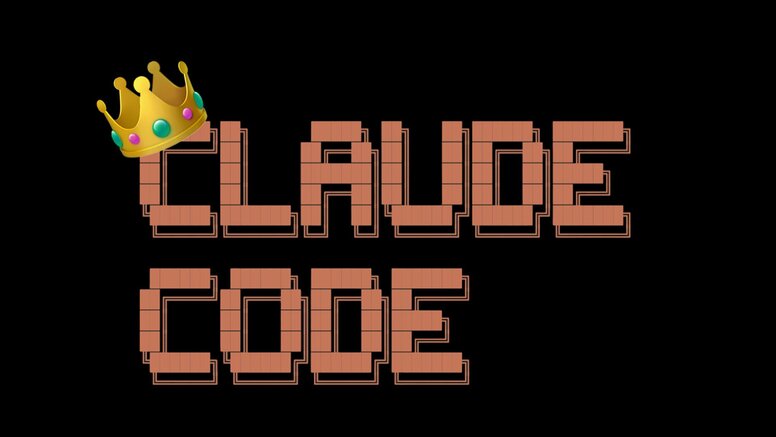
After spending serious time with both tools, here's my take: Claude Code is the better tool for autonomous development. Cursor makes you a faster coder but Claude Code handles entire features, multi-file refactors, and complex implementations from start to finish.
Here's what I do: I use Claude Code for building features, refactoring systems, and tackling the complex stuff. When Claude Code finishes, I open Cursor for the polish. Tab completions for quick edits and minor tweaks to code when I notice something is off. Claude Code builds the house, Cursor paints the walls.
But let's be real about budgets.
If you can only afford one tool, go with VS Code + Claude Code ($20/month). You lose Cursor's Tab completions, but you keep what actually matters: the ability to describe what you want and have it built for you. VS Code is free and has all the extensions you need. Claude Code will handle the complex stuff and save you hours.
Claude Code is something genuinely new. It’s not trying to be a better IDE - it’s reimagining how we interact with code. The terminal interface forces a different workflow where you describe intentions rather than implementations. Letting AI take control requires trust, but the payoff is substantial. You'll find yourself tackling bigger refactors and more ambitious features because Claude Code makes them feasible.
And if you want to tackle even more ambitious features, get your team on Fusion and give everyone Claude Code's power in a visual interface.
Welcome to the future of coding. It’s pretty exciting.
If you enjoyed this post, check out these related articles on our blog:
Builder.io visually edits code, uses your design system, and sends pull requests.
Builder.io visually edits code, uses your design system, and sends pull requests.



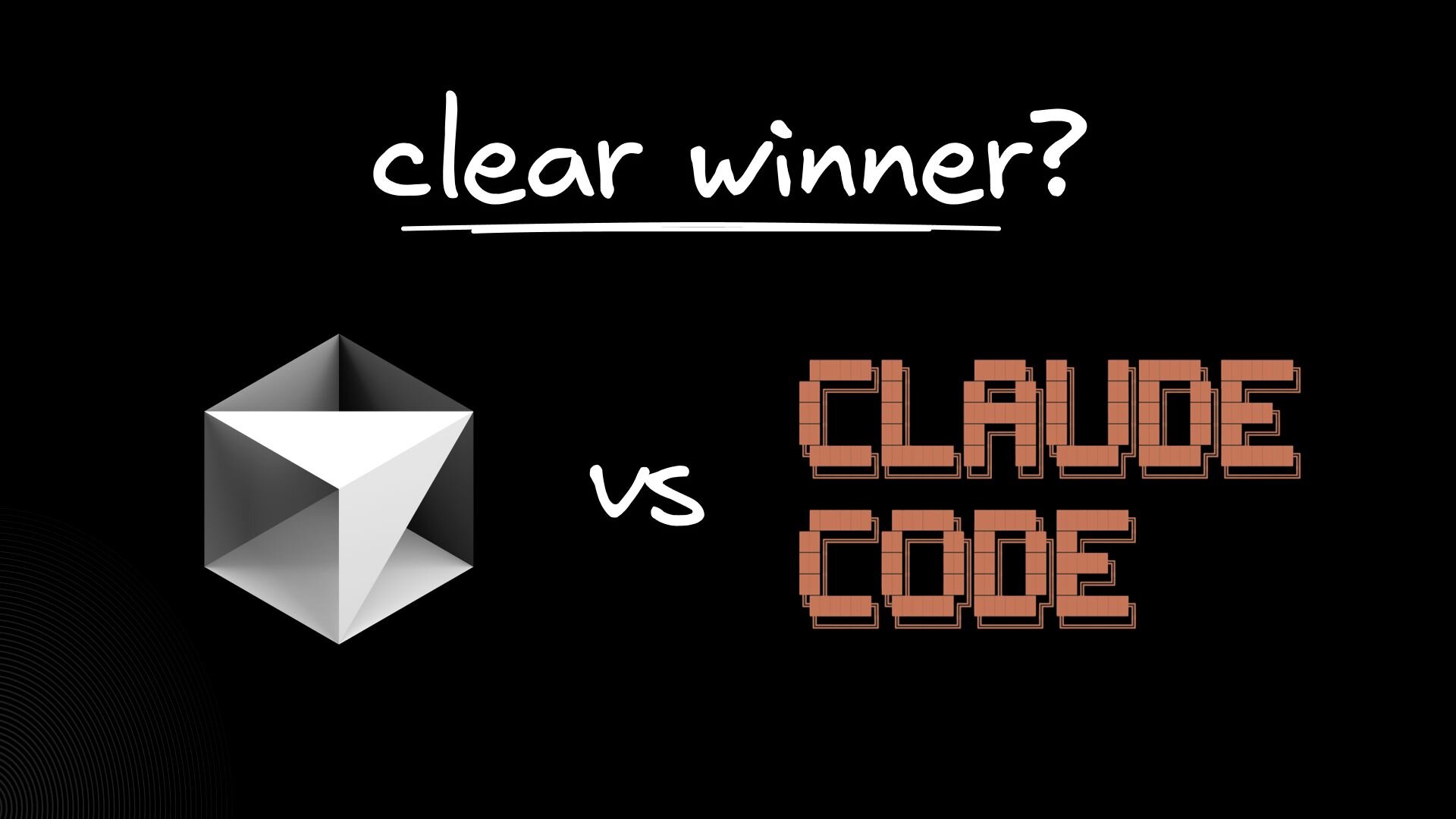
 Connect a Repo
Connect a Repo








